CFTT1
| SITE: CFTT 1 | |
| Location: Mt Worth East | Aust. Soil Class.: Melacic (& Acidic), Dystrophic, Black DERMOSOL. |
| Great Soil Group: brown podsolic | General Landscape Description: Waning upper 10% slope to north-east. |
| Site Description: Eucalypt plantation. | Geology: Cretaceous sediments |
| Mapping Unit: Strzelecki. | |
Note: No landscape photo as the site is in the middle of a plantation forest.
Soil Profile Morphology:
Surface Soil
| A1 | 0 – 20 cm | Very dark brown (10YR2/2) clay loam; strong medium granular structure; very weak consistence moist; pH 4.4; gradual and smooth transition to: | 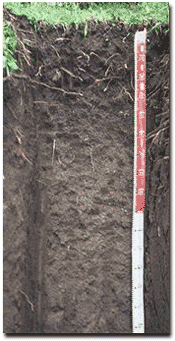 | |
| Subsoil | ||||
| B21 | 20 - 50 cm | Dark brown (7.5YR3/2) light clay; moderate medium polyhedral structure; very weak consistence moist; pH 4.5; diffuse and smooth transition to: | ||
| B22 | 50 – 90 cm | Dark brown (7.5YR3/2) light clay; moderate medium polyhedral structure; weak consistence moist; pH 4.6; diffuse and smooth transition to: | ||
| B23 | 90 – 140 cm | Dark brown (10YR4/3) light medium clay; moderate coarse polyhedral structure; weak consistence moist; pH 4.6; gradual transition to | ||
| B24 | 140-180 cm | Yellowish brown (10YR5/4) light clay; moderate coarse polyhedral structure; weak consistence moist; pH 4.6. | ||
Key Profile Features:
- Lack of strong texture contrast between surface (A) horizon and subsoil (B) horizons
Soil Profile Characteristics:
pH | Salinity Rating | |||
Surface (A1 horizon) | Extremely acid | Very low | Non-sodic | none |
Subsoil (B21 horizon) | Very strongly acid | Very low | Non-sodic | none |
Deeper subsoil (at 1.4 m +) | Very strongly acid | Very low | Non-sodic | none |
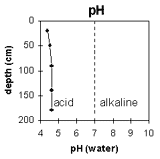 | This profile is strongly acid throughout. | 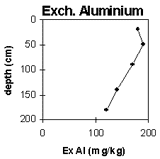 | The aluminium levels are high throughout the profile. |
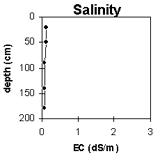 | The salinity rating is very low though the whole profile. | 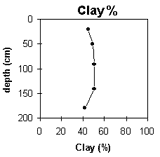 | The clay content is low in the surface, and sharply increases at the A/B interface. |
Horizon | Horizon Depth (cm) | pH (water) | pH CaCl2 | EC (dS/m) | Exchangeable Cations | |||
Ca | Mg | K | Na | |||||
meq/100g | ||||||||
A1 | 0-20 | 4.4 | 4 | 0.12 | 1 | 0.95 | 1.3 | 0.23 |
B21 | 20-50 | 4.5 | 4.1 | 0.12 | 0.41 | 0.43 | 1.2 | 0.3 |
B22 | 50-90 | 4.6 | 4.1 | 0.08 | 0.47 | 0.39 | 0.89 | 0.23 |
B23 | 90-140 | 4.6 | 3.9 | 0.07 | 1.4 | 1.3 | 0.46 | 0.17 |
B24 | 140-180 | 4.6 | 3.9 | 0.07 | 1.8 | 2.2 | 0.31 | 0.24 |
Horizon | Horizon Depth (cm) | Acidity meq/100g | Exchangeable Aluminium mg/kg | Field Capacity pF2.5 | Wilting Point pF4.2 | Coarse Sand (0.2-2.0 mm) | Fine Sand (0.02-0.2 mm) | Silt (0.002-0.02 mm) | Clay (<0.002 mm) |
A1 | 0-20 | 31 | 180 | 48.6 | 26.7 | 3 | 14 | 28 | 45 |
B21 | 20-50 | 30 | 190 | 47.2 | 24.9 | 1 | 13 | 26 | 49 |
B22 | 50-90 | 29 | 170 | 42.4 | 23.5 | 1 | 13 | 28 | 51 |
B23 | 90-140 | 31 | 140 | 38.8 | 22.4 | 0.3 | 14 | 31 | 50 |
B24 | 140-180 | 32 | 120 | 40.7 | 20.4 | 0.2 | 18 | 38 | 42 |
Management Considerations:
- The soil pit was excavated to 2 metres depth. No physical impeding layers were evident. The soil profile is friable throughout when moist and should provide good conditions for root movement.
- The upper soil profile has high levels of exchangeable potassium (K) relative to other basic cations (37% in surface soil and 50% in upper subsoil).
- The soil profile has high wilting point values. This indicates that plants will be unable to extract soil moisture when levels are low.
- The surface soil has a high clay content – making it susceptible to compaction from heavy trafficking or overstocking when in a moist to wet condition.
- Availability of some trace elements (e.g. copper, molybdenum) may be low in very strongly acid soils.


